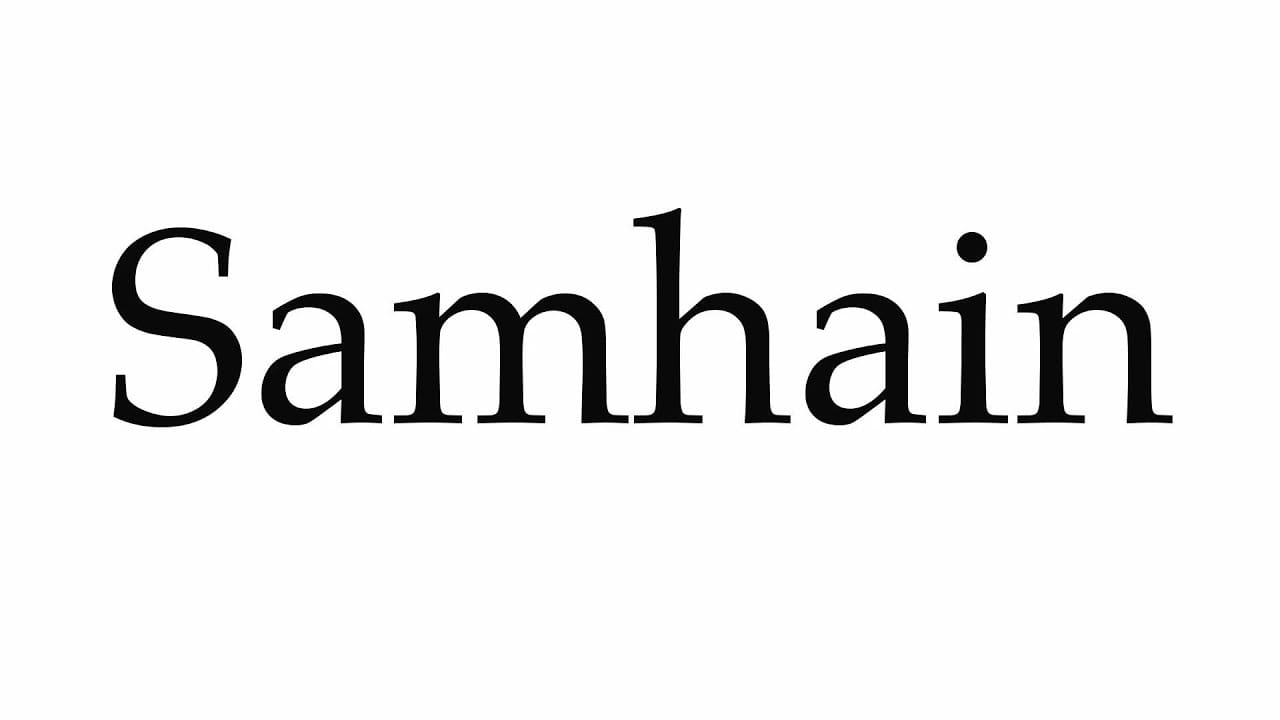Raise your hand if you’ve ever stumbled over pronouncing “Samhain.” You’re not in the minority! This ancient Celtic festival, which celebrates the end of harvest and the start of the colder months, often gets mispronounced as “Sam-Hane.” But let’s set the record straight – it’s actually pronounced closer to “Sow-in” or “Sau-ihn.” So, let’s dive into the correct pronunciation of Samhain, explore its rich history, and uncover the reasons why getting it right matters. Plus, we’ll uncover the fascinating story behind this festival that goes way beyond its connection to Halloween.
Mastering the Samhain Pronunciation
Okay, let’s talk about Samhain. You know, that ancient Celtic festival that marks the end of summer and the arrival of winter? It’s a big deal for a lot of people, and pronouncing it correctly is a sign of respect for its cultural roots. Plus, it just sounds cool.
So, how do you actually say “Samhain” without sounding like you’re trying to clear your throat? It’s pronounced “Sow-in.” Think of a female pig – a “sow” – and then add “in” like you’re saying “win.” Simple, right? “Sow-in.”
Now, you might have heard people say “Sam-hane.” It’s a common mistake, but it’s not accurate and it kind of misses the mark when it comes to honoring Samhain’s Gaelic origins. “Sow-in” is the real deal, the pronunciation that carries the weight of centuries of tradition. Think of it this way: learning the correct pronunciation is like finding a hidden key that unlocks a deeper understanding of this ancient festival. It’s a small change that can make a big difference in how you connect with the spirit of Samhain.
Deconstructing “Sow-wen”: A Phonetic Guide
So, you’ve heard about Samhain, right? This ancient Celtic festival that waves goodbye to summer and welcomes the chill of winter? It’s gaining popularity, but here’s the thing: many stumble over its name. And we get it, pronouncing unfamiliar words can feel like navigating a maze in the dark. But trust us, nailing the pronunciation of “Samhain” isn’t just about getting it right, it’s about tapping into the richness of its history and tradition.
You might have heard folks saying “Sam-hane” – and hey, no judgment, we’ve all been there! – but that’s a little off the mark. Think more along the lines of “Sow-wen.” Picture the “ow” sounding like you’re calling out to a cow, and let that “w” at the end be nice and gentle. It’s all about feeling the flow, you know?
But why does it even matter? Well, imagine going to a friend’s family gathering and accidentally butchering their grandmother’s name. A little awkward, right? Using the correct pronunciation of “Samhain” is like showing respect to the OG celebrants, those rooted in its Irish Gaelic origins. It’s like saying, “Hey, we see you, we appreciate you, and we’re here to honor the traditions that make this celebration so special.”
Want to nail that “Sow-wen” like a pro? Try breaking it down. Think “Sow,” just like our pig pals, and then “wen,” which rhymes with “win.” Go slow, get comfy with each syllable, and before you know it, you’ll be saying “Sow-wen” like you were born doing it.
Here’s the thing about language though, it’s alive! It changes and evolves depending on where you are in the world. So while “Sow-wen” is your go-to pronunciation, you might catch a Scottish Gaelic speaker saying “Samhuinn,” rolling that “r” like a true Scotsman. Language is powerful, and a simple pronunciation can be a sign of respect and understanding. So, the next time you’re talking about Samhain, remember it’s “Sow-wen” – your ticket to appreciating the heart and soul of this ancient festival.
“Sah-Win” or “Sow-in”? Debunking the Myth
So, we’ve already established that “Samhain” isn’t exactly the easiest word to pronounce at first glance. You’re definitely not alone if you’ve heard it both ways – “Sow-in” and “Sah-win.” It’s like that friend’s name you swear you’re saying right until they politely (or not-so-politely) correct you.
Here’s the thing: while “Sah-win” rolls off the tongue pretty easily, the more accurate pronunciation is closer to “Sow-in.” Think of it like this: the “mh” in the middle there acts a bit like a “w” sound.
Why does it matter? Well, for starters, getting the pronunciation right is a nice nod to the whole Celtic background of Samhain. It’s like showing respect to the origins of this ancient Gaelic festival marking that time when the harvest wraps up and winter starts creeping in. Plus, wouldn’t it be great to confidently explain it to someone else at the next Samhain gathering?
Samhain’s Roots: Unraveling the Irish Connection
We’ve talked about how to pronounce Samhain correctly, but now let’s delve a bit deeper into its origins. It’s easy to get things mixed up when talking about Celtic traditions, with their overlapping histories and shared cultural elements.
Think of Samhain like that delicious family recipe passed down through generations. It originated in Ireland – that’s where the recipe was first written down, if you will. Over time, as people moved and families branched out, the recipe, or in our case, the tradition of Samhain, traveled too, especially to other Celtic lands like Scotland, Wales, and the Isle of Man.
Now, even though those other family members might tweak the recipe a bit – maybe adding a pinch of this or that to suit their taste – the core ingredients, the heart of the recipe, remain the same. They’re all still making that same delicious dish, acknowledging the original source while adding their own personal flair.
That’s what happened with Samhain. It started in Ireland, deeply rooted in their ancient traditions and language. That’s why the Irish Gaelic pronunciation, “Sow-in,” is so important; it connects us directly to the source.
But as the Celts spread their influence, Samhain went along for the ride. It became a significant event in other Celtic regions, each adding their own regional flavors and customs to the celebration. So, while we can say with certainty that Samhain’s roots are firmly planted in Irish soil, its branches have definitely reached out and intertwined with other Celtic cultures, making it a beautiful tapestry of shared traditions.
Wishing “Happy Samhain” in Gaelic: A Linguistic Twist
You’ve already got the pronunciation down – “Sow-wen,” like “cow” and “wen” together – but what about wishing someone a happy one? Unfortunately, it’s not quite as straightforward as saying “Happy Samhain” directly in Gaelic.
You see, the concept of directly translating “Happy [Holiday]” isn’t common in many languages, including Gaelic. It’s more about expressing well-wishes specific to the occasion. Think of it like saying “Merry Christmas” – we don’t typically translate the “Merry” part directly.
So, how do you spread the Samhain cheer? Some Gaelic speakers might use phrases that focus on the blessings or good fortune associated with the season, rather than a direct “Happy Samhain” equivalent. It’s a bit of a linguistic quirk, but it highlights how different cultures express festive greetings!
But while a direct “Happy Samhain” might not exist, we can still acknowledge the occasion with respect and a nod to its roots. Perhaps saying something like, “May your Samhain be filled with the magic of the season” would be a beautiful way to do so.
And don’t forget, language is constantly evolving! Who knows, maybe a direct Gaelic equivalent for “Happy Samhain” will emerge as more people embrace this ancient festival.
- Muggsy Bogues was an amazing basketball player despite his size, he played in the NBA for over 14 seasons without causing any injuries.
- At just 19 years old, Wilt Chamberlain joined the Harlem Globetrotters. He spent two seasons with the team before being drafted by the Philadelphia Warriors.
- The Barbie Dreamhouse was first introduced in 1962, and it has been a popular toy for generations. The Dreamhouse has been redesigned and updated over the years, but it has always remained a classic.
- Unlocking Francis Alexander Shields’ Finance Empire: A Comprehensive Biography - July 12, 2025
- Unveiling Francis Alexander Shields: A Business Legacy - July 12, 2025
- Francis Alexander Shields’ Business Career: A Comprehensive Overview - July 12, 2025















